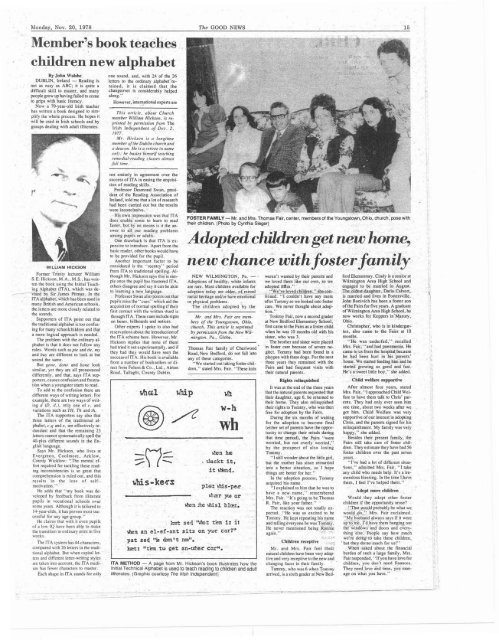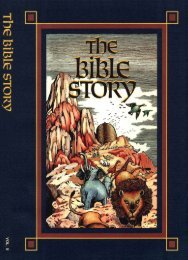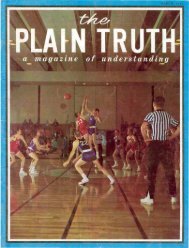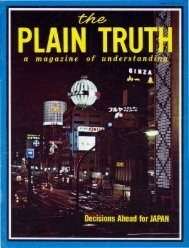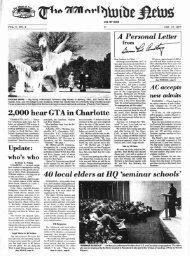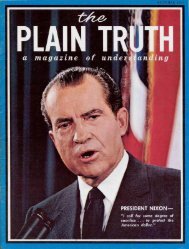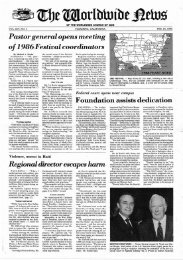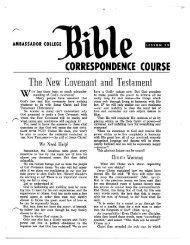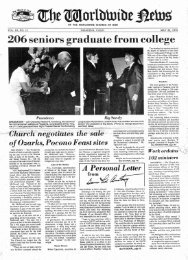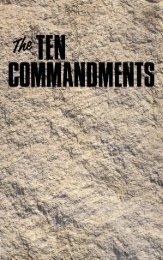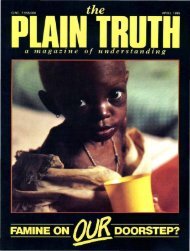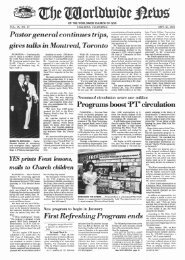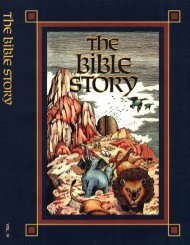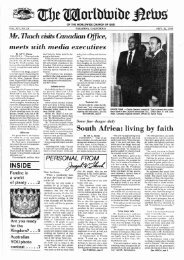Good News 1978 (Prelim No 23) Nov 20 - Herbert W. Armstrong
Good News 1978 (Prelim No 23) Nov 20 - Herbert W. Armstrong
Good News 1978 (Prelim No 23) Nov 20 - Herbert W. Armstrong
You also want an ePaper? Increase the reach of your titles
YUMPU automatically turns print PDFs into web optimized ePapers that Google loves.
M on day, <strong>No</strong>v. <strong>20</strong>, 1 978<br />
Me.mher'~ book teaches<br />
childr-en new alphabet<br />
By Jo hn Walshe .<br />
DUBUN, Ireland - Readin g is<br />
not as easy as ABC; it is quite a<br />
difficult skill to master, and many<br />
people grow up having failed tocome<br />
to grips with basic literacy.<br />
<strong>No</strong>w -a 70-year --old Irish teacher<br />
has written a book designed to simplify<br />
the whole process. He hope s it<br />
will be used -in Irish schools and by<br />
groups dealin g with adult illiterates.<br />
one sound , and . with 24 of the 26<br />
letters to the o rdinary alphabefreta<br />
ined, it is claimed th at the<br />
changeover is considerably helped<br />
along.'<br />
However. intet"!!.ational expert s are<br />
This' art icle, abo ut Chur ch<br />
member William Hickson, is reprinted<br />
by permission from The<br />
Ir ish Ind ependent of Dec . 2,<br />
1977.<br />
Mr . Hickson is a longtime<br />
member of the Dublin church and<br />
a deacon. He is a retiree in name<br />
ontv: he busies 'himself teaching<br />
remedlol-reuding classes almost<br />
fu ll time .<br />
The GOOD NEWS<br />
15<br />
\,<br />
WILLIA M HICK SON<br />
Fonner Trinity lecturer William<br />
S.E . Hick son . M.A .. M.S .• has writ <br />
ten the book using the Initial Te ach<br />
. ing Alphabet (ITA) . which was de<br />
----..---v-ised by Sir J ame s Pitman. In the<br />
ITAalphabet; which has been used in<br />
many British and American schools.<br />
the letters are more closely rela ted to<br />
the sounds.<br />
_ Support ers of ITA point out that<br />
the trad ition al alphabet is too confusing<br />
for many schoo lchildren and that<br />
a more logical approach is needed.<br />
Th e problem with the ordinary alphabet<br />
is that it doe s not follow any<br />
rules . Word s such as pie ·and /ie. my<br />
and buy are different to look at but<br />
sound the same .<br />
But gone , 'done and bone look<br />
similar . yet they are all pronoun ced<br />
differently. and that . says ITA supporters,<br />
ca uses co nfusion and frustration<br />
when a youngster starts to read.<br />
To add to the confusion there are<br />
different ways of writing letters . For<br />
example. there are two ways cf w rit - .<br />
ing d (D, d.). only one of c, and<br />
varia tions such as TH, Th and tho<br />
The ITA supporters say also that<br />
. three letters of the traditi onal alpbabet,<br />
c.o and x, are effectively re<br />
. dundant and that the remainin g <strong>23</strong><br />
letters can not systematically spell the<br />
4O-plus different sounds in the EngtishIanguage.<br />
Says Mr. Hick son . who live s at<br />
Eve rg reen. C ool more . Arkl o w ,<br />
Co unty Wicklow: ·" The .menta l effort<br />
required for tacklin g these reading<br />
inconsistencies is so great that<br />
co mprehens ion is ruled o ut. and this<br />
res ults ' in the loss o f se lf <br />
motivat ion.' :<br />
He adds that " my boo k was developed<br />
by feedback from illitera te<br />
pupils in vocational schoo ls o-ver<br />
some years. Although it is tai lored to .<br />
l-t-yea r-olds , it has prove n most successful<br />
for any age-group."<br />
He clai ms that with it eve n pupils<br />
of a low lQ have been able (0 make<br />
the trans ition to ord inary print in five<br />
week s.<br />
The ITA system h; s 44 characters.<br />
co mpared with 26 letrers in the traditiona!<br />
alphabet. But when capital let- .<br />
rers and differe nt letter-writing styles<br />
are taken into accoun t. the ITA medium<br />
has fewer characters to master.<br />
Each shape in lTA stands for only<br />
not entirel y in agreement over the<br />
succe ss of ITA in eas ing the acquisition<br />
of readin g skills. .<br />
Professor Desmond Swan . president<br />
of the Reading Association of<br />
Ireland . told me that a lot of researc h<br />
had been carried o ur but the-results<br />
were inconcl usive.<br />
. HISown .impression was thai ITA<br />
does enable some to learn to read<br />
faster . but 'bY'no. means is it the answer<br />
to all o ur readin g probl em s<br />
among pupils or ·adults,<br />
.. One drawback 'is that ITA is expensive<br />
to introduce. Apart from the<br />
basic reader. other books would have<br />
to be provided for the pup il.<br />
Another important , factor to be<br />
considered is' the .. reentry " period<br />
from ITA totraditional spelling . AI·<br />
tho ugh Mr . Hickson says this is simpie<br />
once the pupil has mastered ITA,<br />
othe rs disagree and say it can be akin<br />
to learning a new languag e. ,<br />
Professor Swan also poin ts out that<br />
pupils miss the " cue s" which aid the<br />
acqui sition of normal spelling if their<br />
first co ntact with the written word is<br />
through rrA. These cues include signs<br />
on buses. billboards and notices.<br />
Other ex perts I spoke to also had<br />
reservations about the introduction of<br />
the ITA scheme here . Howe ver . Mr .<br />
Hickson repl ies thai none of them<br />
had tried it out experimentally, and if<br />
they had they would ha ve seen the<br />
success-of ITA . His book is available<br />
from a numb er of bookse llers or direct<br />
from Folens & Co ., Lid.• Airton<br />
Road , Tallaght : Count y Dublin .<br />
FOSTER FAMILY - Mr. and Mrs. Thomas Fair, center, men:.bers of the Yo u ngs;~~n , Ohio:~cl, u rC h , pose with<br />
their children. [Photo.by Cynthi,a Sieger)<br />
Adopredchildren:g~t new1W11U!,<br />
ne-w 'c4a1Jc~ with/osterfamily<br />
NEW WILMINGTON, Pa. ~ ,<br />
Adop tions of healthy• white infants<br />
are rare . Most chi ldren available for<br />
ado ption toda y are older, _orl!' i~ e~__<br />
-racia l heritag e and/o r have emotional<br />
'or phys ical problem s.<br />
T he c hild re n adopted<br />
Mr . and Mrs. Fair are mem ~<br />
bus of 1M Youngstown, Ohio,<br />
church . This article is reprinted<br />
. by permission/rom the.New Wil-·<br />
mington, r «, Globe .<br />
Thomas Fair family of Cheriwood<br />
Road . New Bedford. do not fall into<br />
any of these cate gories.<br />
" We started o ut taking foster chil <br />
dren," stated Mrs. Fair. "These kids<br />
Wip<br />
w-h<br />
wh<br />
.lien hEE<br />
, .Ilackt 1t,<br />
it \lienc!.<br />
pl!1':5: :Ad s - p e -r- ~ ,<br />
.l!rer ' ywar ~<br />
Iol!en Jhe 1.!Ji s l blre:s: ~<br />
, ket se er '''hlt t iem 1:s: it<br />
Io!len an el-ef-ant s i ts on ywr 'c ar ?"<br />
pa t sec! "ie cIcen't nre". .<br />
l


